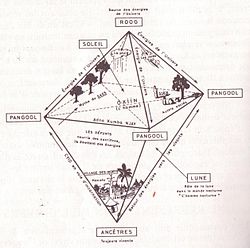Cosmogony

Cosmogony is any model concerning the origin of the cosmos or the universe.[1][2][3]
Overview
Scientific theories

In
Sean M. Carroll, who specializes in theoretical cosmology and field theory, explains two competing explanations for the origins of the singularity, which is the center of a space in which a characteristic is limitless[5] (one example is the singularity of a black hole, where gravity is the characteristic that becomes limitless — infinite).
It is generally accepted that the universe began at a point of singularity. When the universe started to expand, the Big Bang occurred, which evidently began the universe[citation needed]. The other explanation, held by proponents such as Stephen Hawking, asserts that time did not exist when it emerged along with the universe. This assertion implies that the universe does not have a beginning, as time did not exist "prior" to the universe. Hence, it is unclear whether properties such as space or time emerged with the singularity and the known universe.[5][6][clarification needed]
Despite the research, there is currently no theoretical model that explains the earliest moments of the universe's existence (during the
Mythology

In mythology, creation or cosmogonic myths are narratives describing the beginning of the universe or cosmos.
Some methods of the creation of the universe in mythology include:
- the will or action of a supreme being or beings,
- the process of metamorphosis,
- the copulation of female and male deities,
- from chaos,
- or via a cosmic egg.[9]
Creation myths may be

Compared with cosmology
In the humanities, the distinction between cosmogony and cosmology is blurred. For example, in theology, the cosmological argument for the existence of God (pre-cosmic cosmogonic bearer of personhood) is an appeal to ideas concerning the origin of the universe and is thus cosmogonical.[15] Some religious cosmogonies have an impersonal first cause (for example Taoism).[16]
However, in astronomy, cosmogony can be distinguished from
See also
- Anthropic principle – Hypothesis about sapient life and the universe
- Chronology of the universe – History and future of the universe
- Cosmography – Science that maps the universe
- Ultimate fate of the universe – Theories about the end of the universe
- Why is there anything at all?
References
- ^ a b Ridpath, Ian (2012). A Dictionary of Astronomy. Oxford University Press.
- ^ Bibcode:1979QJRAS..20...97W.
- ^ Staff. "γίγνομαι – come into a new state of being". Tufts University. Retrieved 17 September 2014.
- ^ a b Wollack, Edward J. (10 December 2010). "Cosmology: The Study of the Universe". Universe 101: Big Bang Theory. NASA. Archived from the original on 14 May 2011. Retrieved 27 April 2011.
- ^ a b Carroll, Sean (28 April 2012). "A Universe from Nothing?". Science for the Curious. Archived from the original on 10 May 2016. Retrieved 22 April 2019.
- ^ a b Carroll, Sean; Carroll, Sean M. (2003). Spacetime and Geometry: An Introduction to General Relativity. Pearson.
- ^ "String Theory/Holography/Gravity". Center for Theoretical Physics. Retrieved 20 April 2019.
- ^ Becker, Katrin; Becker, Melanie; Schwartz, John (2007). String Theory and M-Theory. Cambridge, UK: Cambridge University Press.
- ^ Long, Charles. "Creation Myth". Encyclopedia Britannica. Retrieved 20 April 2019.
- ^ "Eridu Genesis Mesopotamia Epic". Encyclopaedia Britannica. Encyclopaedia Britannica, Inc. 20 July 1998. Retrieved 30 April 2019.
- JSTOR 4062253.
- ^ Thury, Eva; Devinney, Margaret (2017). Introduction to Mythology Contemporary Approaches to Classical and World Myths, 4th ed. Madison Avenue, New York: Oxford University Press. pp. 4, 187.
- ^ Garverza, J. K. (2014). The Myths of the Philippines. University of the Philippines.
- ^ Jocano, F. L. (1969). Philippine Mythology. Quezon City: Capitol Publishing House Inc.
- ^ a b Smeenk, Christopher; Ellis, George (Winter 2017). "Philosophy of Cosmology". Stanford Encyclopedia of Philosophy. Retrieved 30 April 2019.
- ^ "BBC - Religions - Taoism: Gods and spirits". www.bbc.co.uk. BBC.
External links
 Media related to Cosmogony at Wikimedia Commons
Media related to Cosmogony at Wikimedia Commons
